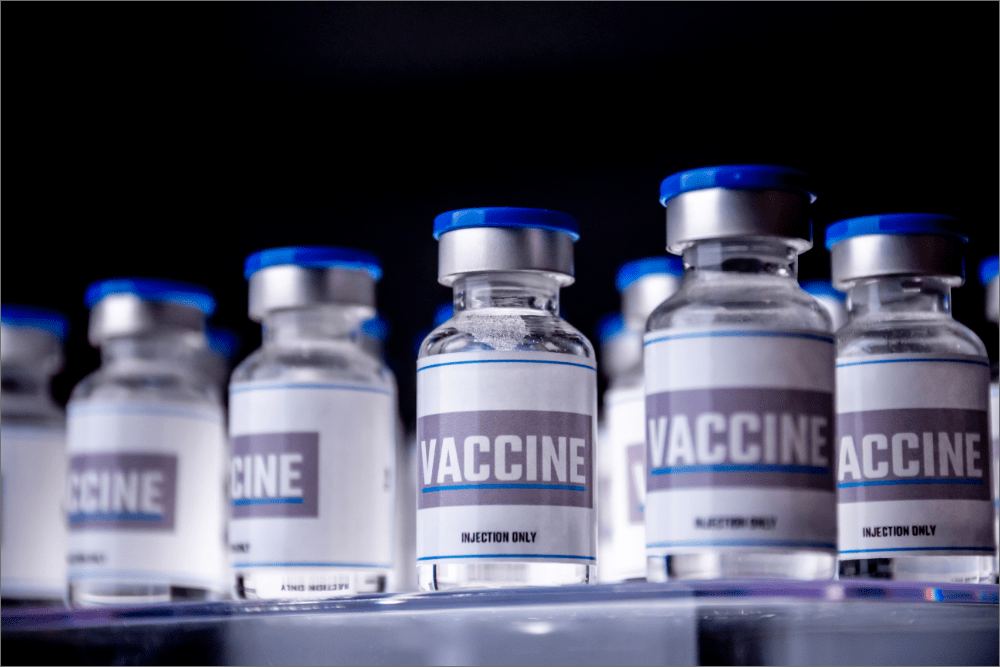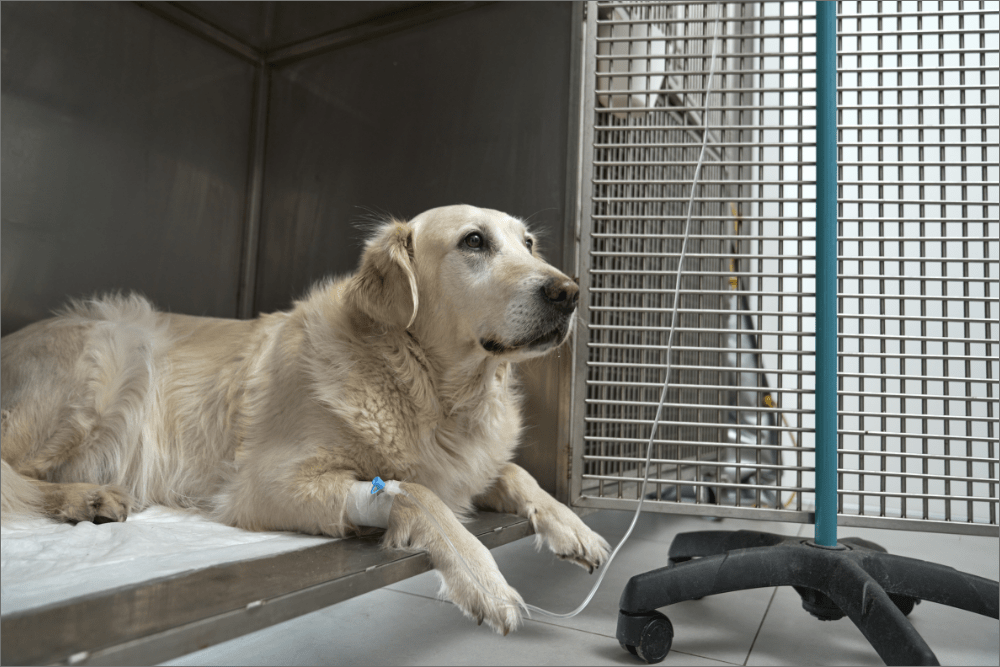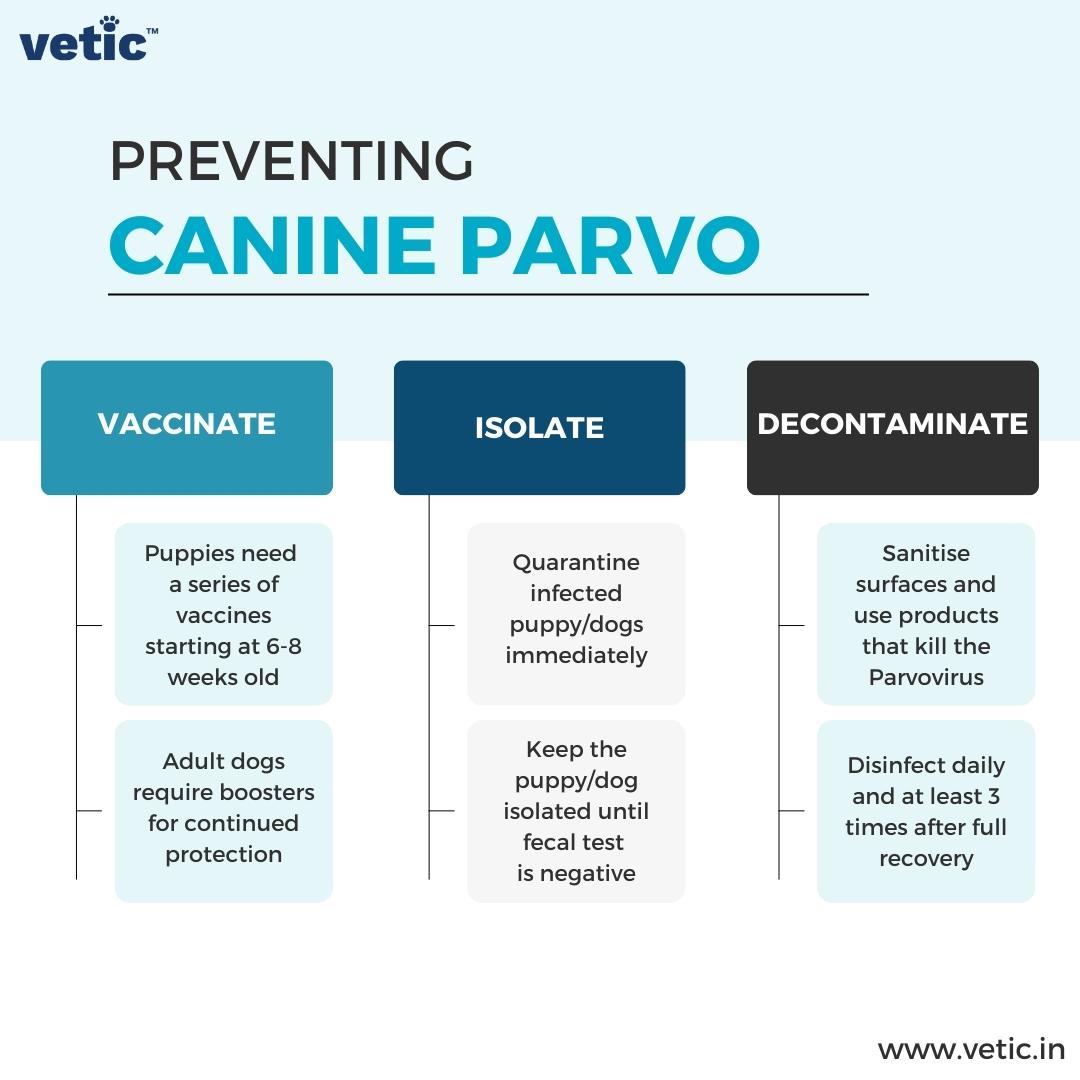Canine parvo or parvo in dogs is a common but dangerous viral disease. It mainly affects unvaccinated puppies between the ages of 6 and 20 weeks. However, canine parvovirus may also affect adult dogs who have not received their parvo vaccine or missed a booster.

Canine parvovirus (CP) is highly contagious. That means if one puppy is infected with canine parvo in a multi-dog household, other unvaccinated puppies and dogs are also at risk.
What causes canine parvo disease?
There are 2 main types of canine parvovirus – CPV1 and CPV2 that have been identified. The more serious signs of canine parvovirus or canine parvo is a result of the canine parvovirus type 2 (CPV) infection. The two types of canine parvovirus CPV2 are CPV-2a and CPV-2b.
Every unvaccinated dog, irrespective of their breed and age, is capable of becoming infected by parvo.
CPV outbreaks are still quite common. The lack of options to get puppies vaccinated and dogs boostered during the COVID-19 pandemic caused a sudden spike in parvo cases across the globe.
The outbreaks are common and keep occurring throughout the year. So, vaccinating your dog or puppy against canine parvovirus is a must. If your pup’s vaccines aren’t up-to-date, visit the Vetic pet hospital near you and ask about puppy vaccination schedules.
CPV infection: How do dogs get parvo?
Canine parvovirus can spread via –
- Direct dog-to-dog contact
- Dog’s contact with contaminated stool
- Contaminated surfaces that contain the viruses
- People who have come in touch with infected dogs (unwashed hands and clothes)
- Contaminated food and water bowls
- Infected leashes, collars and other accessories
Thankfully, it is not an airborne virus. You have to clean the floor, furniture, furnishing, clothes, and your dog’s accessories thoroughly if they have tested positive for canine parvovirus. Cuddling or handling other dogs, after touching a CPV-positive dog can cause further spread of the disease.
If you believe your dog or pup has been exposed to CPV, visit the nearest Vetic dog hospital and request a parvo test. All emergency vet hospitals have parvo testing kits and other tests that can detect CPV.
Most importantly, CPV Type 2 only affects dogs and other canids. It is completely different from the Parvovirus B19 strain that affects humans. Parvovirus B19 only infects humans and cannot be transmitted to dogs or cats.
What are the symptoms of canine parvo: Early signs of parvo in dogs

Canine parvo symptoms are easy to observe in puppies as well as adult dogs. The parvo symptoms include –
- Lethargy
- Depression
- Loss of appetite
- Nausea
- Vomiting
- Diarrhoea
- Blood in stool
Fever is not a common symptom among all parvo cases. Some dogs come down with a sudden high fever after contracting parvo.
In case your pup is showing more than one of these symptoms, rush them to the Vetic emergency dog hospital near you for immediate treatment. Quick action can stop the spread of the disease.
Canine parvo diagnosis: What tests are needed for canine parvovirus diagnosis?

Today, most veterinary clinics, including Vetic pet clinic, have handy kits for instant parvo tests. These kits use faecal samples and rapid antigen test technology. Most of these kits are reliable. Nonetheless, they may show false negative results when your dog is not shedding the viruses through their faeces.
In such cases, the veterinarian may recommend a PCR (Polymerase Chain Reaction) test. It is more sensitive than a RAPID kit and even ELISA. PCR can detect the CPV viral particles (DNA) that are highly specific to canine parvovirus type 2.
The vet will also recommend a complete blood count. One of the biggest indicators of CPV is the sudden decrease in the level of white blood cells (leukopenia). The viruses attack the bone marrow and reduce the production of WBCs drastically.
A combination of a positive CPV faecal test on PCR and a low WBC count is often a confirmed canine parvo diagnosis.
What is the treatment for Canine Parvo?
Canine parvo can be deadly if proper treatment is not provided at the right time. There is no natural remedy for parvo in dogs.
There is currently no antiviral therapy that works for every dog suffering from parvo. So, parvo treatment mostly consists of supportive care, symptomatic treatment, and management of overall health.
One of the biggest challenges posed by parvo is dehydration. The first line of treatment always includes minimizing the fluid loss and rehydrating the pupper. All oral drinks and foods are stopped during treatment. So, all the fluids are given intravenously or subcutaneously, depending upon the age of the puppy.
That makes treating parvo at home quite challenging. Almost all the medication in the initial phases of the treatment should go via an intravenous, intramuscular or subcutaneous route.
Your puppy may require antiemetics and antacids to reduce their discomfort. They will also require antibiotics to minimize the chance of secondary bacterial infections.
They will need to be isolated and kept under constant observation. In-patient care with an isolation treatment area for parvo is the ideal choice for new pet parents. These places have the proper testing methods, IV fluid pumps, standard medicines and emergency medications. These facilities are typically unavailable even in the most caring homes.
Check out Vetic at Sector 45. It has 24/7 in-patient facilities with vets present around the clock. So, even if your pooch begins showing signs of parvo at 2 am, you can find all the answers at Vetic.
What is the lifecycle of canine parvovirus? Why is parvo in dogs dangerous?
The canine parvovirus has an incubation period of about a week. So, an infected dog or puppy won’t show immediate symptoms. The canine parvovirus can stay in a dog’s system without showing any signs for up to 7 days. It is known as the incubation period.
The viruses require rapidly dividing cells inside the puppy’s body. Once it’s done attacking the tonsils and lymph nodes, it moves to the lymphocytes. They piggyback on the lymphocytes to spread throughout the pupper’s bloodstream.
Once in the bloodstream, the canine parvoviruses target the bone marrow and small intestine. It reduces the WBC count and causes significant gastrointestinal distress. Rapidly multiplying viral cells prevent the replacement of the cells on the small intestine wall. It leads to bacterial infections as well.
That’s the main reason most infected dogs begin throwing up and pooping blood. That is also the main reason you should never give oral medicines, oral rehydration solutions and food to a dog with parvo. The intake of food and fluids will further disturb the small intestine (SI) lining and worsen the SI wall integrity.
For very young pups, CPV can also affect the heart muscles causing arrhythmias.
Canine parvovirus can become dangerous and even deadly if it’s not treated on time. To know about the standardized protocol(s) for canine parvo treatment contact or visit Vetic.
Preventing parvo in dogs: How can I save my dog from canine parvo?

Prevention of canine parvo is much easier and more economical than treating the disease.
Your puppy should receive their first CPV vaccine as a part of their combination vaccine that includes canine distemper virus (CDV), canine parainfluenza type 2 virus, infectious canine hepatitis and leptospirosis. One shot is not enough to prevent these infections. Your puppy will require multiple shots up until 16 weeks of age.
Here are a few tips to protect your puppy from canine parvo –
- The only way to ensure that your puppy doesn’t contract CPV is by following the standard vaccination protocol.
- Do not forget to give yearly boosters to your dog to protect them from CPV infection.
- Do not take puppies younger than 120 days, who haven’t received their Puppy DP, DHPPiL Vaccine and booster outside.
- Do not let strangers cuddle your unvaccinated puppy.
Do not leave your puppy in any in-patient care where they do not isolate suspected canine parvo infections.
Never miss another vaccine or booster! Upload your pupper’s prescription and vaccine dates on the Vetic app for timely reminders. Download the Vetic App right here.
FAQs on Canine Parvovirus or Parvo in Dogs
What causes canine parvo disease?
Canine parvo is caused by the highly contagious canine parvovirus (CPV), specifically types CPV-2a and CPV-2b.
It spreads through direct contact with infected dogs, contaminated surfaces, and even via people’s unwashed hands and clothes.
What are the early signs of canine parvo?
Early signs of parvo in dogs include lethargy, depression, loss of appetite, nausea, vomiting, and/or diarrhea.
Dogs will soon develop bloody vomit, bloody diarrhea, and occasionally fever. Prompt veterinary care is crucial if these signs appear.
How do dogs get parvo?
Dogs contract parvo through contact with infected feces, contaminated objects, or direct dog-to-dog contact.
It’s not airborne but can persist on surfaces for long periods, making thorough cleaning essential.
What tests are needed to diagnose canine parvovirus?
Diagnosis typically involves a rapid antigen test using fecal samples. For accuracy, PCR tests can confirm CPV-2 infection.
Blood tests may also reveal leukopenia (low white blood cell count), a hallmark of parvo.
What is the treatment for canine parvo?
Treatment focuses on supportive care: IV fluids to combat dehydration, anti-nausea medications, and antibiotics to prevent secondary infections. There’s no specific antiviral therapy; although some anti-viral medications do help in reducing the viral load.
What is the lifecycle of canine parvovirus?
The virus has an incubation period of about a week before symptoms appear. It targets rapidly dividing cells in the intestines and bone marrow, leading to severe gastrointestinal distress and immune suppression.
Can dogs survive parvo?
With timely and intensive veterinary care, many dogs can survive parvo. However, without treatment, especially in puppies, survival rates drop significantly due to dehydration and secondary infections.
How can I prevent canine parvo?
Prevention involves timely vaccination with a series of CPV vaccines starting at a young age and regular boosters throughout the dog’s life. Avoiding contact with unvaccinated dogs and maintaining hygiene are also crucial.
